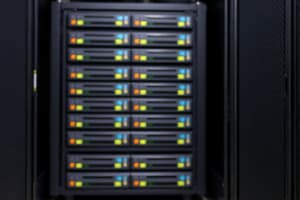Podcast
Questions and Answers
What is the purpose of the Input/Output Interface?
What is the purpose of the Input/Output Interface?
- To control the peripherals connected to the computer
- To synchronize the data transfer rate of peripherals with the CPU
- To transfer information between internal storage and external I/O devices (correct)
- To convert signal values from peripherals to electronic devices
Which devices are considered to be connected online to the computer?
Which devices are considered to be connected online to the computer?
- Devices with electromechnical components
- Devices under direct control of the computer (correct)
- Devices with faster data transfer rate
- Devices with different data codes and formats
What is a major difference between peripherals and the CPU and memory?
What is a major difference between peripherals and the CPU and memory?
- Peripherals have a faster data transfer rate than the CPU and memory
- Peripherals do not require any communication links for interfacing with the central processing unit
- Peripherals use the same data codes and formats as the CPU and memory
- Peripherals are electromechnical and electromagnetic devices, while CPU and memory are electronic devices (correct)
Why might a synchronization mechanism be needed between peripherals and the CPU?
Why might a synchronization mechanism be needed between peripherals and the CPU?
What is the primary function of the I/O Subsystem of a computer?
What is the primary function of the I/O Subsystem of a computer?
Study Notes
Input/Output Interface
- The purpose of the Input/Output Interface is to connect devices to the computer and facilitate communication between them.
Devices Connected Online
- Devices connected to the computer online include keyboards, mice, scanners, printers, and monitors.
Peripherals vs. CPU and Memory
- A major difference between peripherals and the CPU and memory is that peripherals are external devices, whereas the CPU and memory are internal components of the computer.
Synchronization Mechanism
- A synchronization mechanism may be needed between peripherals and the CPU to ensure that data is transmitted and received correctly, as peripherals operate at different speeds and may send or receive data at different times.
I/O Subsystem Function
- The primary function of the I/O Subsystem of a computer is to manage the flow of data between devices and the computer, enabling efficient and accurate data exchange.
Studying That Suits You
Use AI to generate personalized quizzes and flashcards to suit your learning preferences.
Description
Test your knowledge of computer input/output organization with this quiz on peripheral devices. Explore the essential components of the I/O subsystem and the communication between the central system and external environment. Identify and understand the most common input/output devices, including monitors, keyboards, mice, printers, and more.




